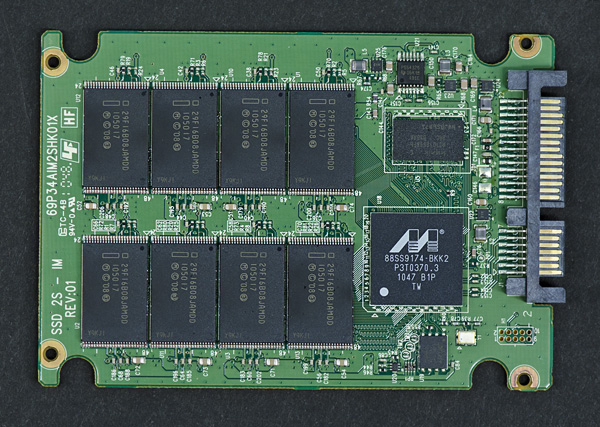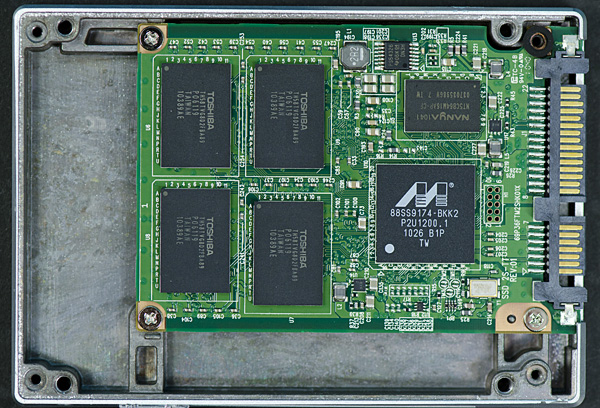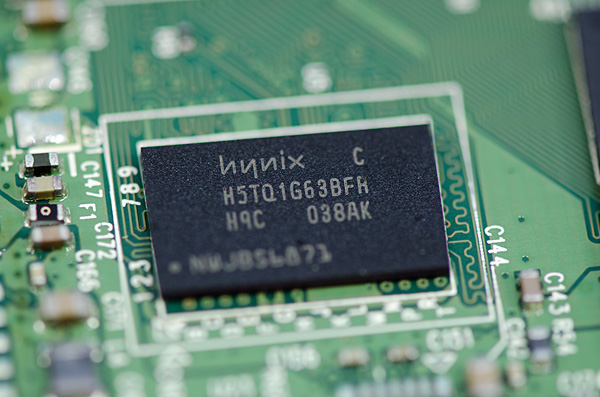The Intel SSD 510 Review
by Anand Lal Shimpi on March 2, 2011 1:23 AM EST- Posted in
- IT Computing
- Storage
- SSDs
- Intel
- Intel SSD 510
Intel’s SSD 510 Powered by Marvell
At IDF 2008 Intel presented a session that discussed its SSDs and what made them better than the competition. Allow me to quote, ahem, myself:
“Intel's SSD design attempts to be different in the three key areas that determine SSD performance: Flash, Firmware and Controller.”
and
“The Firmware and Flash-to-SATA controller are both made by Intel, whereas most SSD makers use off the shelf components and FPGAs for their designs. Intel claims that its expertise in microprocessor and platform design allows for much higher levels of performance out of its SSDs.”
Now allow me to contrast what Intel told me at IDF 2008 with the reality of today in 2011.
The “G3” we’ve all been waiting for will still come. That’ll be Intel’s first 25nm SSD and it should carry specs similar to what we already published. However the focus of the drive will be the mainstream. To take care of the high end Intel created a new drive: the Intel SSD 510 (codename Elmcrest) and it uses a Marvell 9174 6Gbps controller.

Intel's SSD 510 based on Marvell's 88SS9174 controller
Everyone has access to the same NAND that Intel does, but in the past it was controller microarchitecture and firmware that gave Intel the edge. With the 510, the advantage has been reduced to just firmware.
The Marvell 9174 is the same controller Micron uses in its C400 and the same controller in Corsair’s Performance Series 3 SSDs. In fact, I recently received a Corsair P3. Pop off the lid and you’ll see the very same controller Intel is using in the 510:

Corsair's P3 SSD, note the controller similarity
Talk to SandForce and they’ll tell you that the controller itself doesn’t matter - it’s the firmware that matters the most. That’s definitely true to an extent, although I can’t help but feel like you need both microarchitecture and firmware to get the absolute best performance.
Although the controller is sourced from Marvell the firmware and validation are entirely Intel’s. As a result you shouldn't expect the 510 to perform identically to other Marvell based drives.
Intel is also quick to point out that despite using a 3rd party controller, the 510 has to go through Intel’s rigorous validation and testing. Reliability and quality should be no different than any other Intel SSD.
I asked Intel if this was a permanent thing - if we should always expect it to license controllers from third parties for its high performance SSDs. Intel responded by saying that the Marvell controller made sense given the hole in its roadmap, however this is not a long term strategy. While we may see more Intel SSDs based on 3rd party controllers, Marvell’s controller is not a permanent resident in Intel’s SSD roadmap - it’s just here on a student visa.
Paired with the Marvell controller is a 128MB Hynix DDR3-1333 SDRAM. This is technically the largest DRAM to appear on an Intel SSD to date. Even the old X25-M G2 only had a 32MB DRAM on board.
The 510 currently only supports 34nm Intel NAND rated at 5,000 p/e cycles. There are two capacities offered: a 120GB and a 250GB. Intel sent us the 250GB version which has 256GB of 34nm Intel NAND spread out across 16 NAND packages. That’s 16GB per package and 4GB per 34nm die.
Remember the GiB/GB conversion math that’s used to mask spare area in SSDs. With 256GiB of NAND on board and 250GB of storage area promised by the drive, there’s actually only 232.8GiB of user addressable space on the 250GB drive. This puts the percentage of spare area at 9%, an increase over the 6.8% spare area common on the X25-M.
The 120GB drive has even more spare area than the 250GB drive. With 128GB of 34nm NAND on board, the 120GB Intel SSD 510 has 111GiB of user addressable space for a total spare area of 12.7%.
Intel’s rated performance for the SSD 510 is as follows:
| Intel SSD Comparison | ||||||
| X25-M G2 160GB | SSD 510 120GB | SSD 510 250GB | ||||
| NAND Capacity | 160GB | 128GB | 256GB | |||
| User Capacity | 149GB | 111GB | 232GB | |||
| Random Read Performance | Up to 35K IOPS | Up to 20K IOPS | Up to 20K IOPS | |||
| Random Write Performance | Up to 8.6K IOPS | Up to 8K IOPS | Up to 8K IOPS | |||
| Sequential Read Performance | Up to 250MB/s | Up to 400MB/s (6Gbps) | Up to 500MB/s (6Gbps) | |||
| Sequential Write Performance | Up to 100MB/s | Up to 210MB/s (6Gbps) | Up to 315MB/s (6Gbps) | |||
| Price | $404 | $284 | $584 | |||
Ironically enough the SSD 510 fixes the X25-M’s poor sequential performance but trades it for lower random performance. On paper the 510’s random performance is decidedly last-generation. And honestly the rated performance of the 120GB isn’t particularly interesting. The 120GB drive will have fewer NAND die available, and SSDs achieve their high performance by striping data requests across as many NAND die as possible - hence the lower performance specs.
Pricing is set at $284 for the 120GB drive and $584 for the 250GB drive. Intel’s SSD 510 is available today and Newegg marks the two up to $315 and $615 respectively.
The Bundle
Intel sent over the desktop installation kit bundle for the 510. Included in the box is a 3.5" adapter kit, a 6Gbps SATA cable (3Gbps cables of sufficient quality should work fine though) and a 4-pin molex to SATA power adapter:
The 510 also works with Intel's SSD Toolbox, which makes tasks like secure erase super simple:













128 Comments
View All Comments
deadsmeat - Wednesday, March 2, 2011 - link
I am not sure if I missed it, but will you do a price/performance for SSDs? For example, and Intel or Corsair SSD migth be the fastest, but if it has a good price/performance vs the fastest SSD then it's something that consumers might consider when getting an SSD.I don't have a clear "performance" since you have run many benchmark in there, but something like a "real world load" would be good to see. I may not want the fastest SSD, but I will be looking for something that has good over-all balance in performance, and not so heavy on the pocket...
deadsmeat - Wednesday, March 2, 2011 - link
Woops, I missed "not" i.e.Intel or Corsair SSD might NOT be the fastest, but if it has a good price/performance vs the fastest SSD then it's something that consumers might consider when getting an SSD.
dagamer34 - Wednesday, March 2, 2011 - link
I thought that's what the light benchmark was, more "normal" tasks that aren't super-abusive with the SSD.vol7ron - Wednesday, March 2, 2011 - link
Yes, light being "AnandTech Storage Bench 2011 - Light Workload".Either Light or Heavy depending on your use seems to be a combination of both random and sequential performance.
As stated in the article:
"I'll be sharing the full details of the benchmark in some upcoming SSD articles but here are some details:
1) The MOASB, officially called AnandTech Storage Bench 2011 - Heavy Workload, mainly focuses on the times when your I/O activity is the highest. There is a lot of downloading and application installing that happens during the course of this test. My thinking was that it's during application installs, file copies, downloading and multitasking with all of this that you can really notice performance differences between drives.
2) I tried to cover as many bases as possible with the software I incorporated into this test. There's a lot of photo editing in Photoshop, HTML editing in Dreamweaver, web browsing, game playing/level loading (Starcraft II & WoW are both a part of the test) as well as general use stuff (application installing, virus scanning). I included a large amount of email downloading, document creation and editing as well. To top it all off I even use Visual Studio 2008 to build Chromium during the test."
therealnickdanger - Wednesday, March 2, 2011 - link
What price would you use? MSRP? Newegg after MIR? Just pick a usage scenario that fits your usage and divide the score by the dollar amount of your favorite e-tailer... Pretty simple.vol7ron - Wednesday, March 2, 2011 - link
Why not have both? AT has used a price grabber in the past.Actually, where did that go? It started to break down on the old site, but I'd like to see AT put that part shopper back up.
MrDiSante - Wednesday, March 2, 2011 - link
Realistically speaking, if you're buying computer components/peripherals, the functionRetailer GetLowestPrice(Component component)
{
return Newegg;
}
would probably be better than the average price comparison site.
marraco - Wednesday, March 2, 2011 - link
To be useful, the comparison needs to consider RAID 0 setups.dagamer34 - Wednesday, March 2, 2011 - link
It seems like the one true major difference between the Intel SSD 510 and the OCZ Vertex 3 is that one is available now while the other is only talked about in reviews. First to market is always a benefit for a manufacturer that has a decently performing product, though Newegg's markup makes early adopter's pay dearly for it.Of course, this leads to the important question of "when will the Vertex 3 series reach general availability?" I recently purchased a 120GB OCZ Vertex 2 for a new 2011 17" MacBook Pro and the performance is stunning compared to the stock HDD (it's my first SSD). I'm wondering if I should return the drive and just wait for the Vertex 3 because once you've gone SSD, it is so hard to go back!
Thanks for the review Anand!
dagamer34 - Wednesday, March 2, 2011 - link
Oh, another thing. Are we going to get an SSD State of the Union for 2011? I'm guessing you're waiting to finish the reviews of most of the SSDs that are coming out this year first... Yeah, I just answered my own question, I think. :)